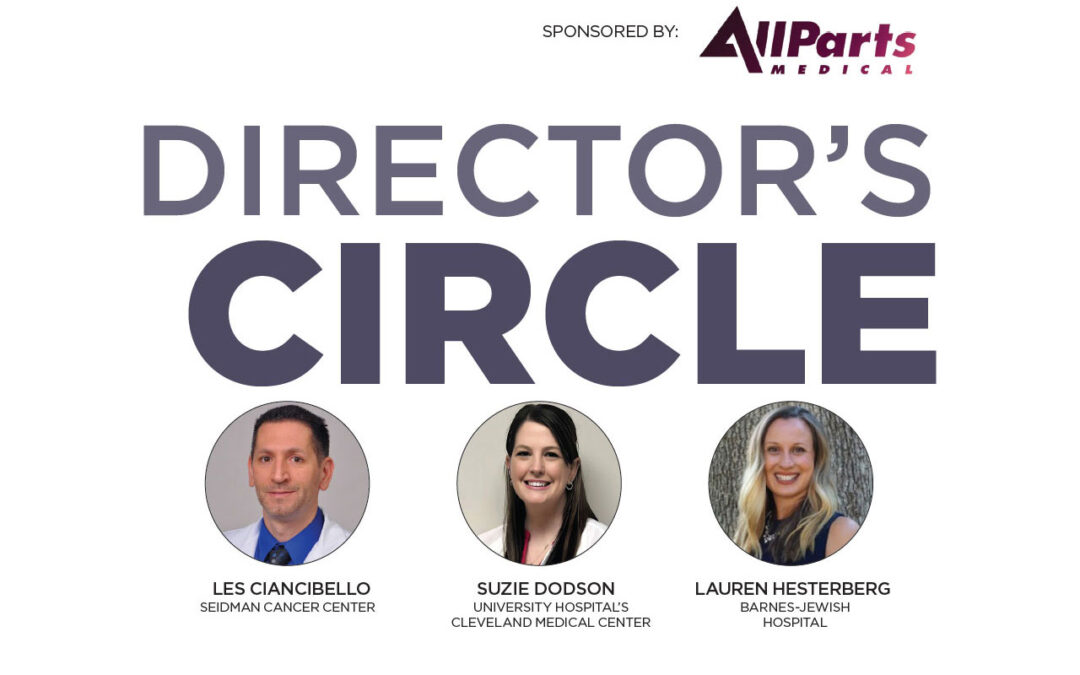In this month’s edition of the Director’s Circle, ICE Magazine asked imaging leaders about CT devices. Information gathered ranges from the latest must-have features to what to look for when buying a new CT scanner. Participating in the roundtable discussion are:
- Seidman Cancer Center Radiology Supervisor Les Ciancibello, RT, (R)(CT);
- University Hospital’s Cleveland Medical Center CT Scan Supervisor Suzie Dodson, BA, RT (R)(CT); and
- Barnes-Jewish Hospital CT Clinical Applications Specialist Lauren Hesterberg.

Q: What are some must-have features when purchasing a new CT scanner?
Ciancibello: Wide “Z” coverage and fast rotation speed.
Dodson: Fast rotation time and larger detector coverage area for fast and high-quality scanning, and advanced safety features that make the patient experience more positive.
Hesterberg: Technologists and CT departments across the country are working with growing volumes of patients and adapting to great advances in technology; with these great opportunities and fast-paced working environments, patient safety must be incorporated to support technologists. Built-in and customizable features are heavily investigated in the clinical environment to help support the workflows currently in place. For example, any opportunity for the CT scanner and injector system to automate the protocol to perform based on the information coming from the EHR, would be a highly sought after technology that supports patient safety and workflows.
2. What are the 2 or 3 most important factors when selecting a new CT scanner?
Ciancibello: Ease of use for the end user, highly reliable, dedicated workflows.
Dodson: A user friendly machine with the latest advanced technology and ability to do scans that will reflect our hospital’s mission, “To Teach, To Heal and To Discover.”
Hesterberg: The newest forms of dose-reduction technology, software algorithms to increase image quality, and dual energy capability are the top factors implemented and continuously improved upon in an academic CT department. Radiation dose reduction will continue to be a focus with CT imaging so that ALARA is a focus for continuous quality improvement. Scanning techniques that utilize advanced filtration, such as Sn150, allow for up to 60% dose reduction in some applications. The newest form of iterative reconstruction should be on the scanner, which allows for another level of dose reduction. Software algorithms to assist with metal artifact reduction, beam hardening, and the capability to create additional reconstructions for dual energy scans will be integral in a modern CT unit.
3. What are some tips for creating an efficient CT department?
Ciancibello: You must have highly trained staff to run an efficient CT department. As we have seen over the years of CT technological advances – no matter how “fast” the machine can image a human – if you do not have technologists and support staff along with an optimized workflow process then productivity will not increase.
Dodson: Great communication skills between all employees involved in scanning from registration, to nursing to technologist to radiologist. Highly trained technologists that understand “the what, the way and the why” of scanning and not just how to use the machine to get the images requested.
Hesterberg: First, it is useful to utilize the technology that is available to help support the technologists. For example, any optimization with the EHR or with the scanner itself should be investigated. A few areas that have assisted with efficiency include auto-sending of images and utilization of vendor platforms to auto-create reconstructions to save technologist’s time. Beyond technology, creating a space for continuous improvement using the PDSA model has built an environment of adaptability as well as increased comfort with change. When the technologists are actively looking for ways to improve, they identify the most opportunities to increase efficiency that also have the biggest impacts.
4. As an imaging leader, which departments do you work with when it is time to purchase a new CT?
Ciancibello: I feel it is most important to work with the physician groups. It is critical that they understand the limitations of the technology that is being purchased.
Dodson: Radiologists should always be involved to understand the functions of the machine and if there is any new technology that we can utilize regarding research or innovation. Also, to get input from technologists that are going to be working on the machine on a daily basis should be considered.
Hesterberg: At Barnes-Jewish Hospital, the ICU and emergency departments have been great partners for the CT department. The patients from these departments generally have the highest acuity and require advanced levels of care, so involvement from these partners has helped ensure patients receive the highest quality of care while in the CT department. The ICU team was heavily involved during the onboarding of a new portable CT unit and a fixed CT unit, which are both located in the ICU department, but operated by radiology. Working together to build a standard of care for patients imaged in the ICU helped ensure each department was aware of expectations as well as how to utilize the scanner. When onboarding the portable CT unit, the ICU nursing teams were allowed to ask questions during training so they could best understand how the unit operates while in a patient suite. Building relationships early with these teams has helped all involved gain a better understanding about how each department operates and then subsequently work better together when operating new equipment.
5. What else should ICE Magazine readers know about CT?
Ciancibello: Computed tomography is the “go-to” technology. It is fast, has relatively easy access, and little if anything can hide from it.
Dodson: There is more to CT than just scanning routine brains and abdomens, the technology and capabilities of CT is ever growing, and CT technologists take pride in leading the future of advanced imaging.
Hesterberg: CT is an imaging modality that is heavily used due to the ability to image quickly and gain the most information about the patient in a short amount of time. Vendors are building platforms to take CT imaging a step further and utilize AI to assist in the patient care plan. Because of these continuing advancements, it will be crucial for leaders to remain abreast of new technology to set their teams up for the best success, which ultimately leads to the best quality of care for the patients served.
This month’s article was sponsored by AllParts Medical. For more information on this company, visit allpartsmedical.com.










